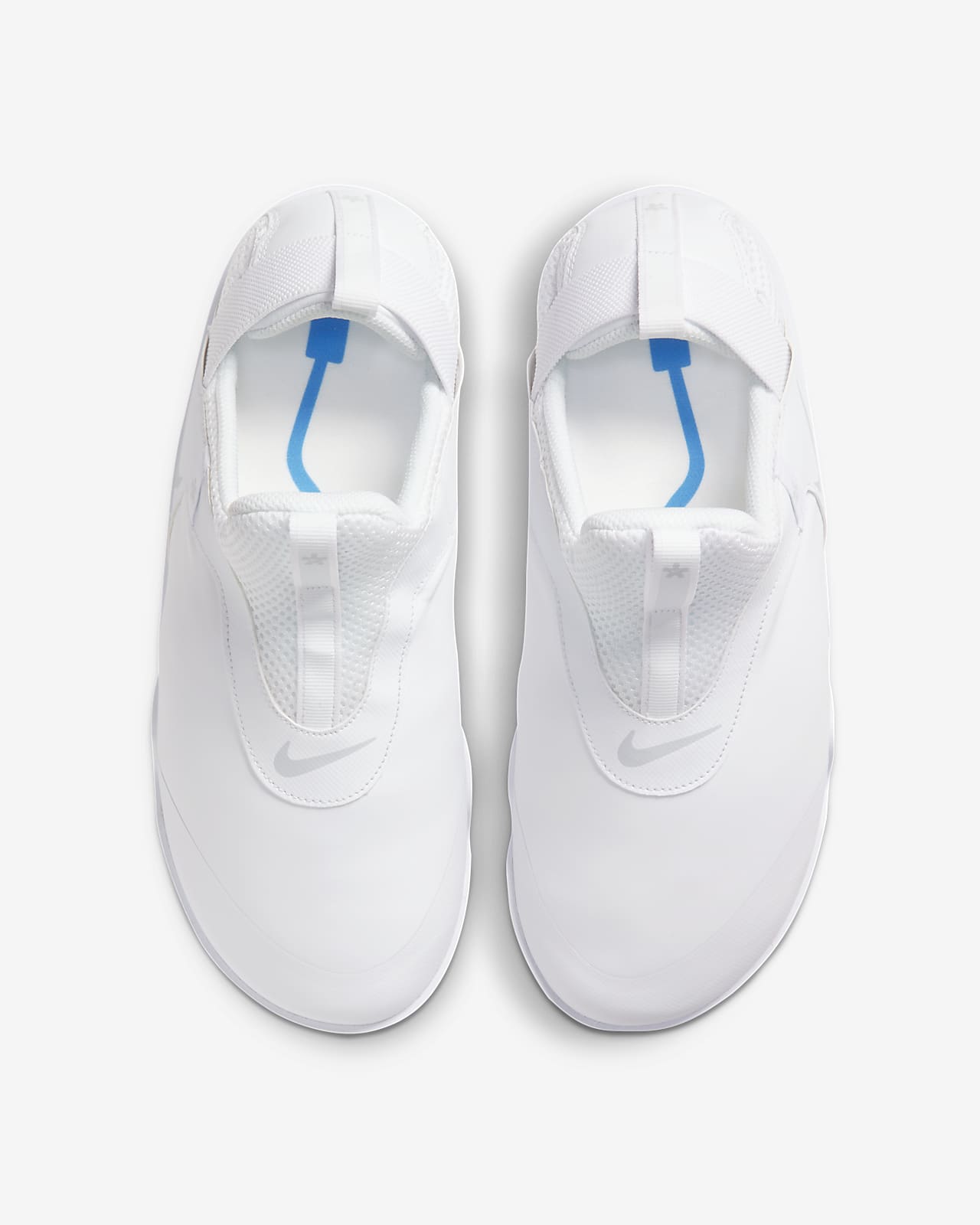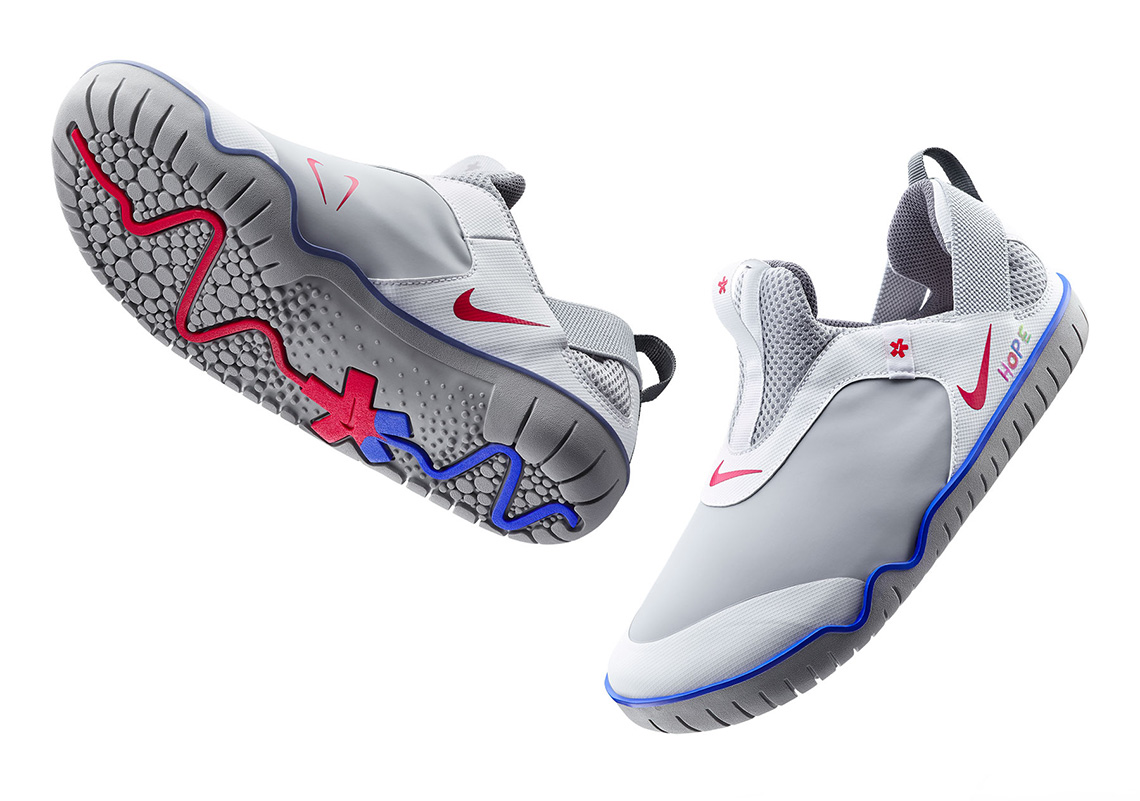The 1960s[edit]
- Established as 'Blue Ribbon Sports' by University of Oregon track athlete Phil Knight and his coach, Bill Bowerman, on January 25, 1964.[1] The company initially operated in Eugene, Oregon as a distributor for Japanese shoe maker Onitsuka Tiger, making most sales at track meets out of Knight's automobile.[2] In its first year in business, BRS sold 1,300 pairs of Japanese running shoes grossing $8,000.[citation needed] By 1965, sales had reached $20,000. In 1966, BRS opened its first retail store at 3107 Pico Boulevard in Santa Monica, California. In 1967, due to increasing sales, BRS expanded retail and distribution operations on the East Coast, in Wellesley, Massachusetts.[3]

Nike Air Zoom Pulse. NikeCourt Air Zoom Vapor Cage 4. NikeCourt Air Zoom Vapor Cage 4. Women’s Hard Court Tennis Shoe.
The 1970s[edit]
- 1971
- Graphic designer Carolyn Davidson created the famous Nike 'Swoosh' logo and sold it to the company for US$35.00.[4]
- Renamed from Blue Ribbon Sports, and debuted the waffle iron trainers invented by Bill Bowerman.[5]
The 1980s[edit]
- Nike Womens Air Zoom Pegasus 37 Tb Casual Running Shoe Cj0506-100. 4.4 out of 5 stars 18. Nike Men's Air Zoom Winflo 6 Track & Field Shoes, Women US 16. 4.6 out of 5 stars 252. FREE Shipping by Amazon. Nike Men's Race Running Shoe.
- Buy Nike Zoom Pulse here: or Originally built for and tested by nurses, Kahleah's Nike Zoom Pulse Doernbecher.
- 1983
- Nike introduces the Pegasus, the first edition of a successful line of running shoes that continues to this day.[6]
Nike also starts making clothing
- Air Jordans were first introduced in 1984 exclusively for Michael Jordan. They were released to the public in late 1984.
The 1990s[edit]
- The first Nike store opens in downtown Portland.
- Nike opens its world headquarters in unincorporated Washington County, just west of Portland, on 74 acres (0.3 km²) of land.
- 1993
- Nike introduces Reuse-A-Shoe, which collects athletic shoes,
- Nike wins Advertiser of the Year at the Cannes Advertising Festival.
- Nike enters the ice hockey market after acquiring Canstar, the parent company of hockey equipment manufacturer Bauer Hockey. Nike had only made hockey jerseys, specifically those of the Edmonton Oilers at the height of Wayne Gretzky-mania, but now began to make all equipment.
- Nike moves into English football, signing a kit (uniform/apparel) deal with Arsenal.
- 1995
- Nike signs long-term partnerships with the Brazilian and United States soccer teams.
- 1996
- Nike signs Tiger Woods soon after he gives up his amateur golf status.
- Nike causes controversy with its advertising campaign during the Summer Olympics in Atlanta which features the slogan, 'You Don't Win Silver — You Lose Gold.' Nike's use of this slogan draws harsh criticism from many sources, including - not surprisingly - several former Olympic silver and bronze medalists.
- Niketown Los Angeles opens in Beverly Hills.
- 1997
- Nike signs several hockey stars, including Sergei Fedorov and Jeremy Roenick, to endorsement deals to wear their new line of skates, which are noticeably different due to their unique colors and design. Fedorov especially became known for his unique 'all-white' Nike skates, which were radically different from the normally black standard hockey skates. Although Wayne Gretzky would eventually wear the all-white Nike skates in his final season, Nike decided to make more traditional skates for their next product line.
- 1998
- Phil Knight commits Nike to standards for its affiliated manufacturing facilities, including: minimum wage; air quality; education programs; expansion of microloan program; factory monitoring; and enhanced transparency of Nike's corporate social responsibility practices.
- Nike Introduces the first 'tennis shoe' style golf shoe into the market. Golfers everywhere rejoice and the trend of comfortable golf shoes starts.
- 1999
- Bill Bowerman, co-founder of Nike, dies on Dec. 24 at age 88.
The 2000s[edit]
- 2000
- Nike Shox cushioning/support system is introduced, initially worn by Vince Carter and others on the US Olympic basketball team.
- 2002
- Nike purchases Hurley International, an action sports clothing company, for an undisclosed amount.
- NikeGO launches, a grassroots initiative to increase physical activity among youths aged 9–15.
- Nike become the apparel sponsor of Manchester United until 2010.
- Nike SB, Nike's Skateboarding line, debuts.
- 2003
- Nike acquires once-bankrupt rival Converse for $305 million on July 9.
- For the first time in the company's history, international sales exceed USA sales.
- Nike is again (also in 1994) named 'Advertiser of the Year' by the Cannes Advertising Festival.
- Nike signs NBA player LeBron James with an unprecedented $87 million endorsement contract.
- 2004
- Phil Knight steps down as the CEO and President of Nike, but continues as chairman. Knight is replaced by William D. Perez as CEO of Nike, effective Dec. 28.
- Nike creates the Exeter Brands Group, a wholly owned subsidiary for athletic footwear and apparel brands for lower price points. Brands include Starter, Team Starter, Asphalt, Shaq, and Dunkman.
- Annual revenues exceed $12.25 billion
- 2005
- Nike reports annual revenue for fiscal year 2005 (ending May 31) of $13.74 billion, a 12% increase over the previous fiscal year.
- Nike Signs Tennis Pro Rafael Nadal.
- Nike introduces Nike Free.
- 2007
- Nike enters the cricket market with a 5-year sponsorship of the Indian cricket team for US$43m.
- CEO William Perez leaves Nike on January 23, 2006. Perez said in the statement that he and Knight 'weren't entirely aligned on some aspects of how to best lead the company's long-term growth. It became obvious to me that the long-term interests of the company would be best served by my resignation.'
- Mark Parker replaces Perez as CEO. Parker had been brand co-president of the company, and joined Nike in 1979.
- Nike and Apple release the Nike+iPod sports kit, enabling runners to log and monitor their runs via iTunes and the Nike+ website.
- Nike reports annual revenue for fiscal year 2006 (ending May 31) of $15 billion.
- 2007
- Nike introduces the Second Coming, a group of NBA basketball players who best represent the Nike Basketball.
- Nike introduces AF25, after 25 years of Air Force shoe line.
- 2009
- Nike sells its Nike Bauer hockey equipment division.
- Nike introduces shoes featuring new Flywire and Lunarlite Foam materials. Flywire is a new technology made up of thin wires of vectran fibers, which are 5 times stronger than steel and never lose strength. Lunar Foam is a material developed by NASA that gives the shoe excellent shock absorption and a great feel with minimal weight.
- Nike reports annual revenue for fiscal year 2008 (ending May 31) of $18.6 billion, a 14% increase over the previous fiscal year
- 2009
- Dwyane Wade moves from one Nike subsidiary to another, switching from Converse to Jordan Brand.
The 2010s[edit]
- 2012
- Nike introduces Flyknit,[7] a threading technology allowing lighter and more breathable shoe upper.
- 2017
- Nike introduces the HyperAdapt 1.0 which were inspired from the Air Mags in the Back to the Future Part II movie.
- The Vaporfly 4% running shoe was introduced, inspired by the Breaking2 attempt to break the 2-hour marathon barrier. This shoe main feature is a carbon fiber plate in the midsole for improved propulsion and energy return.[8]
References[edit]


- ^O'Reilly, Lara. '11 Things Hardly Anyone Knows About Nike'. Business Insider. Retrieved January 26, 2020.
- ^O' Reilly, Lara (November 4, 2014). '11 Things Hardly Anyone Knows About Nike.'BusinessInsider.com. Retrieved December 28, 2014.
- ^'Nike Company History'.
- ^'Creator of Nike's famed Swoosh remembers its conception 40 years later'. OregonLive.com. Retrieved 2018-01-11.
- ^'Bill Bowerman, His Wife's Waffle Iron, Nike's Early Days and Birth of the Modern Running Shoe | Natural Running Center'. naturalrunningcenter.com. Retrieved 2018-01-11.
- ^http://www.complex.com/sneakers/2013/09/the-complete-history-of-the-nike-air-pegasus
- ^'Nike Engineers Knit For Performance'. Nike News. 21 February 2012. Retrieved 10 March 2016.
- ^https://www.wired.com/2017/03/nike-zoom-vaporfly-elite/
design
Check Out Nike's New Ground-Up Design for Medical Workers
Nike Air Pulse Zoom Triple Black
November 08, 2019
One can think of the Air Zoom Pulse as almost a traditional clog made athletic — all the arch and posture support of that industry favorite is augmented in the Pulse, with a smooth capacity for natural motion.
Offutt Air Pulse Newspaper
And, of course, the shoe is also fabricated for the unforeseen peculiarities of life in the hospital. The coated toe box protects against any type of spill. Smooth surfaces present a unique challenge when designing for spills as well, and the shoe's traction pattern solves for this by removing closed cells.
Now in its 16th year, the Doernbecher Freestyle Program benefits innovative health care advances at OHSU Doernbecher Children's Hospital. This year's six patient designers have added an Air Zoom Pulse to their individual collections. Those six versions of the shoe will release December 7 on nike.com and at Nike Portland. All profits will be donated to OHSU Doernbecher Children's Hospital.
Desiree Castillo's Design
Kahleah Corona's Design
Ethan Ellis' Design
Bransen Fernando's Design
Nike Air Pulse Zoom Nhs
Sawyer Miller's Design
Zion Thompson's Design
Update: The launch colorways of the Nike Air Zoom Pulse release December 13 on nike.com.
